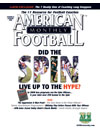AMERICAN FOOTBALL MONTHLY THE #1 RESOURCE FOR FOOTBALL COACHES
Article CategoriesAFM Magazine
|
How To Get The Most Out Of Practice Time As An Assistant Coachby: Joe SchotlandAssistant Coach, Westwood High School (MA) © More from this issue Football programs at all levels from Pop Warner to the NFL have to deal with similar challenges. Your practice time is limited. Your playbook is unlimited. Your next opponent presents numerous difficulties. As a result, many coaches struggle weekly with the same dilemma: How are we going to get all this done? The answer, of course, is that every staff must get the most of practice time. But how? While many clinics, books, and articles advise head coaches how to plan a week or day of practice, there is too little advice for an assistant coach on how to plan the part of practice he is responsible for: the individual period, or ³indy." This article hopes to fill that void. The first key is that the coaches must communicate well among themselves. At the pro and college level, that¹s often easy, because coaching is a full....The full article can only be seen by subscribers. Subscribe today!
|
|
|||||||
| HOME |
MAGAZINE |
SUBSCRIBE | ONLINE COLUMNISTS | COACHING VIDEOS |
Copyright 2025, AmericanFootballMonthly.com
All Rights Reserved





